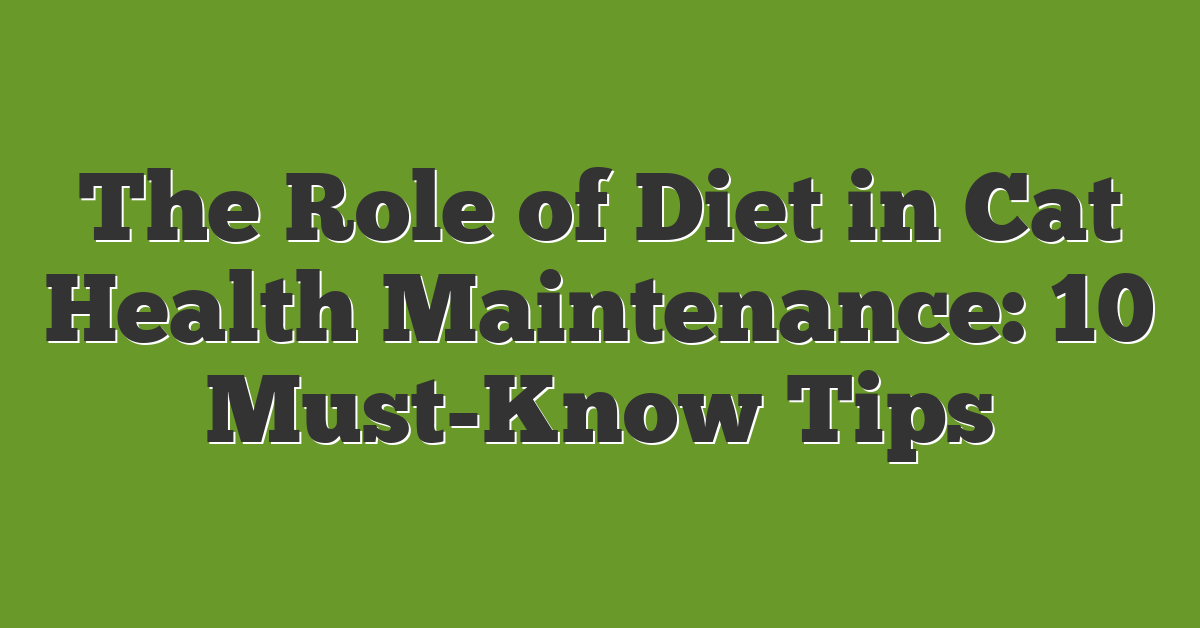Eating right is key to your cat’s health and happiness. You might not realize how much their diet affects their energy levels, coat shine, and overall well-being. Choosing the right food isn’t just about filling their bowl—it’s about giving them the nutrients they need to thrive.

With so many options available, it can be overwhelming to decide what’s best for your feline friend. Understanding the role of diet in maintaining your cat’s health empowers you to make informed choices. Let’s explore how the right nutrition keeps your cat active, prevents illnesses, and ensures a long, joyful life.
Importance of Diet in Cat Health
Your cat’s diet plays a crucial role in maintaining their overall health. Proper nutrition supports their energy levels, ensuring they stay active and playful. A balanced diet contributes to a shiny, healthy coat, reducing shedding and preventing skin issues.
A well-fed cat has a stronger immune system, helping them fight off illnesses more effectively. Managing your cat’s weight through the right diet prevents obesity, which can lead to diabetes and joint problems. Additionally, good nutrition supports healthy organ function, keeping your cat’s kidneys and liver in top condition.
Feeding your cat high-quality food provides essential vitamins and minerals they need daily. For example, taurine supports heart health, while omega-3 fatty acids promote brain function. Choosing the right diet helps your cat live a longer, happier life.
Maintaining a consistent feeding schedule and portion control further enhances your cat’s health. By selecting appropriate foods, you ensure your cat receives all necessary nutrients without overfeeding. This balance is key to preventing health issues and promoting longevity.
| Nutrient | Benefit |
|---|---|
| Taurine | Heart health |
| Omega-3 Fatty Acids | Brain function, coat quality |
| Vitamins A & E | Immune support, skin health |
| Calcium | Strong bones and teeth |
| Protein | Muscle maintenance, energy |
Choosing the right diet for your cat involves understanding their specific needs. Different life stages and health conditions require tailored nutrition. By prioritizing your cat’s diet, you support their well-being and ensure they thrive every day.
Essential Nutrients for Cats
Understanding the essential nutrients helps you provide the best diet for your cat’s health. Each nutrient plays a specific role in maintaining their well-being.
Proteins
Proteins support your cat’s muscle growth and repair. They provide energy and are vital for a strong immune system. High-quality animal proteins, such as chicken, beef, and fish, are essential. Cats require about 25-30% protein in their diet to thrive.
Fats
Fats supply concentrated energy and aid in the absorption of vitamins. They promote a healthy coat and skin. Omega-3 and omega-6 fatty acids, found in fish oil and flaxseed, reduce inflammation and support brain function. Aim for fats to make up 15-20% of your cat’s diet.
Vitamins and Minerals
Vitamins and minerals ensure your cat’s body functions properly. Vitamin A supports vision, while vitamin D helps calcium absorption. Minerals like calcium and phosphorus build strong bones and teeth. Taurine, an essential amino acid, is crucial for heart and eye health. Ensure your cat’s diet includes a balanced mix of these nutrients for optimal health.
Types of Cat Diets
Choosing the right diet helps maintain your cat’s health. You can choose between commercial and homemade options.
Commercial vs Homemade
Commercial Diets
- Convenience: Ready-to-feed and easy to store.
- Balanced Nutrition: Formulated to meet all dietary needs.
- Variety: Available in different flavors and types.
Homemade Diets
- Control Ingredients: You decide what your cat eats.
- Customization: Tailor the diet to your cat’s specific health needs.
- Freshness: Serve freshly prepared meals.
Note: Homemade diets require careful planning to ensure nutritional balance.
Wet vs Dry Food
Wet Food
- Hydration: High moisture content supports kidney health.
- Palatability: Often more flavorful, appealing to cats.
- Easier to Chew: Suitable for cats with dental issues.
- Convenience: Easy to store and serve.
- Dental Benefits: Helps reduce plaque buildup.
- Cost-Effective: Generally cheaper than wet food.
| Type | Pros | Cons |
|---|---|---|
| Wet Food | High moisture, tasty, easy to chew | More expensive, shorter shelf life |
| Dry Food | Convenient, dental benefits, affordable | Low moisture, may contain more carbohydrates |
Common Dietary Issues in Cats
Your cat’s diet plays a big role in their health. Here are some common dietary problems to watch out for.
Obesity
Overfeeding leads to obesity in cats. Obese cats are more likely to develop diabetes, arthritis, and heart disease. To prevent this, measure your cat’s food and avoid too many treats. Choose a balanced diet with the right amount of calories for your cat’s age and activity level.
Kidney Disease
Kidney disease affects many cats, especially older ones. A diet low in phosphorus and protein helps manage this condition. Wet food can provide extra hydration, supporting kidney function. Always work with your vet to choose the best food for a cat with kidney issues.
Food Allergies
Cats can be allergic to ingredients like beef, dairy, or fish. Symptoms include itching, vomiting, and diarrhea. If you suspect a food allergy, try switching to a hypoallergenic or limited-ingredient diet. Consult your veterinarian to identify the right diet for your cat.
Tips for Maintaining a Healthy Diet for Your Cat
Choose High-Quality Food
Select cat food that lists meat as the first ingredient. Look for brands with essential nutrients like taurine and omega-3 fatty acids. Check for AAFCO certification to ensure balanced nutrition.
Control Portion Sizes
Use the feeding guidelines on the cat food package as a starting point. Adjust portions based on your cat’s age, weight, and activity level. Avoid free-feeding to prevent overeating.
Establish a Feeding Schedule
Feed your cat at the same times each day. Consistent meal times help regulate digestion and prevent begging. Typically, adult cats eat two meals daily.
Provide Fresh Water
Always have fresh water available. Change the water at least once a day. Consider a cat water fountain to encourage drinking and improve hydration.
Monitor Your Cat’s Weight
Regularly check your cat’s weight. Use a pet scale for accuracy. If you notice weight gain or loss, consult your veterinarian to adjust the diet accordingly.
Incorporate Wet Food
Include wet food in your cat’s diet to increase moisture intake. Wet food supports kidney health and helps prevent urinary issues. Aim for at least one meal of wet food daily.
Avoid Harmful Foods
Keep your cat away from toxic foods like chocolate, onions, and garlic. Do not give cats dog food or human snacks high in salt and fat. Stick to cat-safe treats.
Gradually Introduce New Foods
When changing your cat’s diet, do it slowly. Mix a small amount of new food with the current food over a week. This helps prevent digestive upset and ensures acceptance.
Read Food Labels Carefully
Check ingredient lists for fillers and artificial additives. Opt for foods with natural ingredients and avoid those with excessive carbohydrates. Prioritize protein-rich options.
Consult Your Veterinarian
Regularly talk to your vet about your cat’s dietary needs. They can recommend specific diets for health issues like allergies or kidney disease. Professional advice ensures optimal nutrition.
Encourage Natural Eating Behaviors
Use puzzle feeders to make mealtime engaging. This stimulates your cat’s mind and can prevent overeating. It also mimics natural hunting behaviors.
Store Food Properly
Keep cat food in a cool, dry place. Use airtight containers to maintain freshness and prevent pests. Follow the expiration dates to ensure your cat consumes fresh food.
Supplement When Necessary
Ask your vet about supplements if your cat has specific health needs. Supplements like omega-3s or probiotics can enhance your cat’s diet. Only use supplements recommended by professionals.
Observe and Adapt
Watch your cat’s eating habits and health closely. Changes in appetite or energy levels can indicate dietary issues. Adapt the diet as your cat grows or as health needs change.
Keep Treats Minimal
Limit treats to no more than 10% of your cat’s daily caloric intake. Choose healthy treats that contribute to their overall nutrition. Avoid giving too many high-calorie snacks.
Maintain Consistency
Stick to a consistent diet to avoid gastrointestinal issues. Sudden changes can cause stress and digestive problems. Consistency supports long-term health and well-being.
Promote Dental Health
Provide dry kibble that helps clean teeth and reduce plaque buildup. Consider dental treats or toys to maintain oral hygiene. Good dental health contributes to overall health.
Balance Wet and Dry Food
Combine wet and dry food to offer variety and balance nutrition. Wet food adds moisture, while dry food supports dental health. A balanced diet ensures comprehensive nutrition.
Address Special Needs
Customize your cat’s diet if they have special health requirements. Tailored diets can manage conditions like obesity, diabetes, or kidney disease. Work with your vet to create the best plan.
Keep Feeding Areas Clean
Clean bowls daily to prevent bacteria growth. Use separate bowls for food and water to maintain hygiene. A clean feeding area supports your cat’s health.
Stay Informed
Keep up with the latest research on cat nutrition. Knowledge about dietary needs evolves, and staying informed helps you make the best choices for your cat’s health.
Reward with Healthy Options
Use healthy food options as rewards during training or play. Choose nutritious treats that support your cat’s diet. Healthy rewards reinforce good behavior without harming their diet.
Provide Balanced Nutrition
Ensure your cat’s diet includes all essential nutrients. Balance proteins, fats, vitamins, and minerals for overall health. A balanced diet supports every aspect of your cat’s well-being.
Maintain a Safe Feeding Environment
Feed your cat in a quiet, safe area free from stress and distractions. A peaceful environment promotes better eating habits and reduces anxiety-related issues.
Regular Health Check-Ups
Schedule regular vet visits to monitor your cat’s health and diet effectiveness. Early detection of dietary problems ensures timely intervention and maintains health.
Encourage Physical Activity
Pair a healthy diet with regular exercise. Active cats maintain a healthy weight and support muscle tone. Use toys and playtime to keep your cat physically engaged.
Avoid Overfeeding
Respect portion sizes to prevent obesity. Use measuring cups or a scale to ensure accurate feeding. Overfeeding leads to health issues and reduces your cat’s quality of life.
Keep a Feeding Journal
Track your cat’s diet, preferences, and any changes in health. A journal helps identify patterns and adjust the diet as needed. It provides valuable information for your vet visits.
Support Longevity with Diet
A well-maintained diet contributes to a longer, healthier life for your cat. Proper nutrition prevents diseases and keeps your cat active and happy throughout their life.
Conclusion
Taking care of your cat’s diet is a big step towards ensuring they stay happy and healthy. By paying attention to their nutritional needs and making informed choices you can help them lead a vibrant life. Keep an eye on their weight and behavior and adjust their meals as needed. Your cat will thank you with companionship and purring for years to come
















